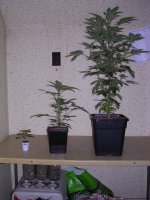yup im gonna do the same for the next run.. ive never used wet and dry cycle per say.. but id let the coco get to the point were it very slightly tans on top around the edges of the pot. and the pots are noticeably lighter.
I think the issue is that I don't have enough veg time in the final container. and even though the roots are very well developed, they are not developed enough to cope with multiple feeds. im sure if I could veg them longer under hps and let them get really root bound, id be good to go.
so im guessing that im not gonna be able to multifeed unless I increase veg time.
ive tried to research nitrogen toxicity being caused by overwatering. so found not found anything. but im guessing the excess water is causing a lockout or something which is causing the symptoms of n toxicity.
next run im going to run the left rows on one nute schedule and the right row on something different. both with ro.. and see how that finishes up. I will post up pics at some point.
either way, if it was the water, ive switched to ro anyway so that at least crosses that off the list of unknowns..
How much up potting do you do from clone to veg stage ? i now go from rooted clone into a solo cup for 1 week to build roots & then right into my 3 gallon pot in veg & it saves me at least 2 weeks veg time & the pots are very well rooted by the time my 4 week veg is over .
7/23
8/19
just under 4 weeks of veg & they're more than ready for flower !
2 days into flower on 8/23






